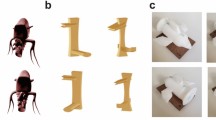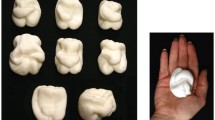Abstract
The cognitive trait of hypnotizability modulates sensorimotor integration and mental imagery. In particular, earlier results show that visual recognition of ‘nonmeaningful’, unfamiliar objects bimanually explored is faster and more accurate in subjects with high (Highs) than with low hypnotizability (Lows). The present study was aimed at investigating whether Highs exhibit a similar advantage after unimanual exploration. Recognition frequency (RF) and Recognition time (RT) of correct recognitions of the explored objects were recorded. The results showed the absence of any hypnotizability-related difference in recognition frequencies. In addition, RF of the right and left hand was comparable in Highs as in Lows, while slight differences were found in RT. We suggest that hemispheric co-operation played a key role in the better performance of Highs in the bimanual task previously studied. In the unimanual exploration, the task’s characteristics (favoring the left hand), hypnotizability-related cerebral asymmetry (favoring the right hand in Highs) and the possible preferential verbal style of recognition in Lows (favoring the right hand in this group) antagonize each other and prevent the occurrence of major differences between the performance of Highs and Lows.



Similar content being viewed by others
References
Amedi A, Raz N, Azulay H, Malach R, Zohary E (2010) Cortical activity during tactile exploration of objects in blind and sighted humans. Restor Neurol Neurosci 28:143–156
Badan M, Caramazza A (1997) Haptic processing by the left hemisphere in a split-brain patient. Neuropsychologia 35:1275–1287
Bloom JS, Hynd GW (2005) The role of corpus callosum in interhemispheric transfer of information: excitation or inhibition? Neuropsychol Rev 15:59–71
Castellani E, Carli G, Santarcangelo EL (2011) Visual identification of haptically explored objects in high and low hypnotizable subjects. Int J Clin Exp Hypn 59:250–265
Cikurel K, Gruzelier J (1990) The effect of an active-alert hypnotic induction on lateral asymmetry in haptic processing. Br J Exp Clin Hypn 7:17–25
Cohen H, Levy J (1986) Cerebral and sex differences in the categorization of haptic information. Cortex 22:253–259
De Pascalis V, Bellusci A, Russo PM (2000) Italian norms for the Stanford Hypnotic Susceptibility Scale, Form C. Int J Clin Exp Hypn 48:15–23
Draca S (2010) Gender-specific functional cerebral asymmetries and unilateral cerebral lesion sequelae. Rev Neurosci 21:421–425
Eshel N, Ruff CC, Spitzer B, Blankenburg F, Driver J (2010) Effects of parietal TMS on somatosensory challenge interhemispheric rivalry accounts. Neuropsychologia 48:3470–3481
Findlay R, Ashton R, McFarland K (1994) Hemispheric differences in image generation and use in the haptic modality. Brain Cogn 25:67–78
Gazzaniga MS (2000) Cerebral specialization and interhemispheric communication: does the corpus callosum enable the human condition? Brain 123:1293–1326
Green JP, Barabasz AF, Barrett D, Montgomery GH (2005) Forging ahead: the 2003 APA Division 30 definition of hypnosis. Int J Clin Exp Hypn 53:259–264
Gruzelier JH (2006) Frontal functions, connectivity and neural efficiency underpinning hypnosis and hypnotic susceptibility. Contemp Hypn 23:15–32
Gruzelier JH, Brow TD, Perry A, Rhonder J, Thomas M (1984) Hypnotic susceptibility: a lateral predisposition and altered cerebral asymmetry under hypnosis. Int J Psychophysiol 2:131–139
Horton JE, Crawford HJ, Harrington G, Downs JH 3rd (2004) Increased anterior corpus callosum size associated positively with hypnotisability and the ability to control pain. Brain 127:1741–1747
Luce RD (1963) Detection and recognition. In: Luce RD, Bush RR, Galanter E (eds) Handbook of mathematical psychology, vol 1. Wiley, New York, pp 103–189
Lynn SJ, Green JP (2011) The sociocognitive and dissociation theories of hypnosis: toward a reapproachment. Int J Clin Exp Hypn 59:277–293
Menzocchi M, Paoletti G, Huber A, Carli G, Cavallaro FI, Manzoni D, Santarcangelo EL (2010) Hypnotizability and sensorimotorintegration: an Italian space agency project. Int J Clin Exp Hypn 58:122–135
Menzocchi M, Santarcangelo EL, Carli G, Berthoz A (2012) Hypnotizability-dependent accuracy in the reproduction of haptically explored paths. Exp Brain Res 216:217–222
Miquée A, Xerri C, Rainville C, Anton JL, Nazarian B, Roth M, Zennou-Azogui Y (2008) Neuronal substrates of haptic shape encoding and matching: a functional magnetic resonance imaging study. Neuroscience 152:29–39
Naish PL (2010) Hypnosis and hemispheric asymmetry. Conscious Cogn 19:230–234
Norman JF, Norman HF, Clayton AM, Lianekhammy J, Zielke G (2004) The visual and haptic perception of natural object shape. Percept Psychophys 66:342–351
Oldfield RC (1971) The assessment and analysis of handedness: the Edinburgh inventory. Neuropsychology 9:97–113
Razumnikova OM, Bryzgalov AO (2006) Frequency-spatial organization of brain electrical activity in creative verbal thought: the role of the gender factor. Neurosci Behav Physiol 36:645–653
Ricciardi E, Pietrini P (2011) New light from the dark: what blindness can teach us about brain function. Curr Opin Neurol 24:357–363
Santarcangelo EL, Scattina E, Carli G, Macerata A, Manzoni D (2008a) Hypnotizability-dependent modulation of postural control: effects of alteration of the visual and leg proprioceptive inputs. Exp Brain Res 191:331–340
Santarcangelo EL, Scattina E, Orsini P, Bruschini, Ghelarducci B, Manzoni D (2008b) Effects of vestibular and neck proprioceptive stimulation on posture as a function of hypnotizability. Int J Clin Exp Hypn 56:170–184
Santarcangelo EL, Scattina E, Carli G, Ghelarducci B, Orsini P, Manzoni D (2010) Can imagery become reality ? Exp Brain Res 206:329–335
Savazzi S, Mancini F, Marzi CA (2008) Interhemispheric transfer and integration of imagined visual stimuli. Neuropsychologia 46:803–809
Scattina E, Huber A, Menzocchi M, Paoletti G, Carli G, Manzoni D, Santarcangelo EL (2012) Postural effects of imagined leg pain as a function of hypnotizability. Exp Brain Res 216:341–348
Sergent J (1990) The neuropsychology of visual image generation: data, method, and theory. Brain Cogn 13:98–129
Acknowledgments
Research funded by the Italian Space Agency. We acknowledge the helpful criticism of Prof. M Di Stefano in the interpretation of results and in the drawing up of the paper.
Conflict of interest
None
Author information
Authors and Affiliations
Corresponding author
Rights and permissions
About this article
Cite this article
Castellani, E., Carli, G. & Santarcangelo, E.L. Hypnotizability and haptics: visual recognition of unimanually explored ‘nonmeaningful’ objects. Exp Brain Res 221, 137–142 (2012). https://doi.org/10.1007/s00221-012-3154-0
Received:
Accepted:
Published:
Issue Date:
DOI: https://doi.org/10.1007/s00221-012-3154-0




